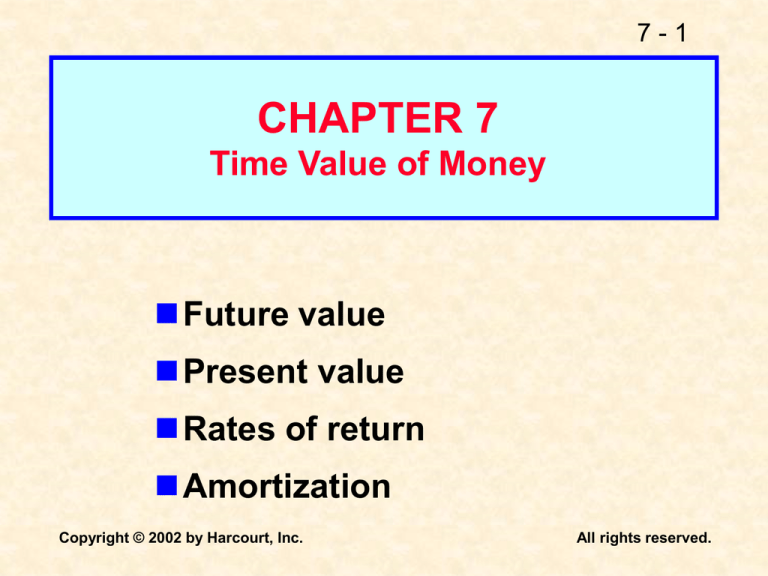
7-1
CHAPTER 7
Time Value of Money
Future value
Present value
Rates of return
Amortization
Copyright © 2002 by Harcourt, Inc.
All rights reserved.
7-2
Time lines show timing of cash flows.
0
1
2
3
CF1
CF2
CF3
i%
CF0
Tick marks at ends of periods, so Time 0
is today; Time 1 is the end of Period 1;
or the beginning of Period 2.
Copyright © 2002 by Harcourt, Inc.
All rights reserved.
7-3
Time line for a $100 lump sum due at
the end of Year 2.
0
1
2 Year
i%
100
Copyright © 2002 by Harcourt, Inc.
All rights reserved.
7-4
Time line for an ordinary annuity of
$100 for 3 years.
0
1
2
3
100
100
100
i%
Copyright © 2002 by Harcourt, Inc.
All rights reserved.
7-5
Time line for uneven CFs -$50 at t = 0
and $100, $75, and $50 at the end of
Years 1 through 3.
0
1
2
3
100
75
50
i%
-50
Copyright © 2002 by Harcourt, Inc.
All rights reserved.
7-6
What’s the FV of an initial $100 after 3
years if i = 10%?
0
1
2
3
10%
100
FV = ?
Finding FVs is compounding.
Copyright © 2002 by Harcourt, Inc.
All rights reserved.
7-7
After 1 year:
FV1 = PV + INT1 = PV + PV(i)
= PV(1 + i)
= $100(1.10)
= $110.00.
After 2 years:
FV2 = PV(1 + i)2
= $100(1.10)2
= $121.00.
Copyright © 2002 by Harcourt, Inc.
All rights reserved.
7-8
After 3 years:
FV3 = PV(1 + i)3
= $100(1.10)3
= $133.10.
In general,
FVn = PV(1 + i)n.
Copyright © 2002 by Harcourt, Inc.
All rights reserved.
7-9
Four Ways to Find FVs
Solve the equation with a regular
calculator.
Use tables.
Use a financial calculator.
Use a spreadsheet.
Copyright © 2002 by Harcourt, Inc.
All rights reserved.
7 - 10
Algebraic Solution
FVn = PV(1 + i)n.
FV3 = 100(1 + .10) 3
FV3 = 100(1.331) = 133.10
Copyright © 2002 by Harcourt, Inc.
All rights reserved.
7 - 11
Solution Using Tables
FVn = PV(FVIF i,n).
FV3 = 100(FVIF 10%, 3)
Use FVIF table from pages A-6
& 7, Table A3
FV3 = 100(1.331) = 133.10
Copyright © 2002 by Harcourt, Inc.
All rights reserved.
7 - 12
Financial Calculator Solution
Financial calculators solve this
equation:
FVn = PV(1 + i)n.
There are 4 variables. If 3 are
known, the calculator will solve
for the 4th.
Copyright © 2002 by Harcourt, Inc.
All rights reserved.
7 - 13
Here’s the setup to find FV:
INPUTS
3
N
10
I/YR
-100
PV
0
PMT
OUTPUT
FV
133.10
Clearing automatically sets everything
to 0, but for safety enter PMT = 0.
Set: P/YR = 1, END
Copyright © 2002 by Harcourt, Inc.
All rights reserved.
7 - 14
What’s the PV of $100 due in 3 years if
i = 10%?
Finding PVs is discounting, and it’s
the reverse of compounding.
0
1
2
3
10%
PV = ?
Copyright © 2002 by Harcourt, Inc.
100
All rights reserved.
7 - 15
Solve FVn = PV(1 + i )n for PV:
FVn
PV = (1 + i)n = FVn
(
1
PV = $100
1.10
)
3
(
)
1 n
.
1+i
= $100(PVIFi,n) Table A1
= $100(0.7513) = $75.13.
So the (PVIF 10%,3) = .7513
Copyright © 2002 by Harcourt, Inc.
All rights reserved.
7 - 16
Financial Calculator Solution
INPUTS
3
N
OUTPUT
10
I/YR
PV
-75.13
0
PMT
100
FV
Either PV or FV must be negative. Here
PV = -75.13. Put in $75.13 today, take
out $100 after 3 years.
Copyright © 2002 by Harcourt, Inc.
All rights reserved.
7 - 17
If sales grow at 20% per year, how long
before sales double?
Solve for n:
FVn = $1(1 + i)n;
n
$2 = $1(1.20)
ln 2 = ln 1.2n
.693147=.18232n
3.801 = n
Use calculator to solve, see next slide.
Copyright © 2002 by Harcourt, Inc.
All rights reserved.
7 - 18
If sales grow at 20% per year, how long
before sales double?
Solve for n:
FVn = PV(FVIF i,n);
$2 = $1(FVIF 20,n)
2.00 = (FVIF 20,n)
n between 3 and 4 years
1.728 and 2.0736
Use calculator to solve, see next slide.
Copyright © 2002 by Harcourt, Inc.
All rights reserved.
7 - 19
INPUTS
OUTPUT
N
3.8
20
I/YR
-1
PV
0
PMT
2
FV
Graphical Illustration:
FV
2
3.8
1
Year
0
1
Copyright © 2002 by Harcourt, Inc.
2
3
4
All rights reserved.
7 - 20
Compound Growth
How do you find the compound growth
rate for your company to analyze sales
growth ?
Can use either PV or FV formula, use FV
1062021 (1 + i )9 = 5284371
(1 + i )9 = 5284371/1062021
(1 + i)9 = 4.976
(1 + i) = 4.976 .111
(1 + i) = 1.195
i = .195 or 19.5%
Copyright © 2002 by Harcourt, Inc.
All rights reserved.
7 - 21
Tabular Solution
Use PV formula and table A-1
5284371 (PVIF i,9) = 1062021
PVIF i,9 = 1062021/5284371
PVIF i,9 = .20097
Use table A-3, for 9
Periods, find .20097
i is between 18% and 20%
Copyright © 2002 by Harcourt, Inc.
All rights reserved.
7 - 22
Calculator Solution, Compound
Growth
INPUTS
9
-1062021 0
N
OUTPUT
I/YR
PV
PMT
5284371
FV
19.51
Copyright © 2002 by Harcourt, Inc.
All rights reserved.
7 - 23
What’s the difference between an
ordinary annuity and an annuity due?
Ordinary Annuity
0
i%
1
2
3
PMT
PMT
PMT
1
2
3
PMT
PMT
Annuity Due
0
i%
PMT
Copyright © 2002 by Harcourt, Inc.
All rights reserved.
7 - 24
What’s the FV of a 3-year ordinary
annuity of $100 at 10%?
0
1
2
100
100
3
10%
Copyright © 2002 by Harcourt, Inc.
100
110
121
FV = 331
All rights reserved.
7 - 25
Algebraic Solution
FVA =( PMT)* ( 1 +i)n – 1
I
FVA =( 100)* ( 1 + .1)3 – 1
.1
FVA =( 100)* 1.331 – 1 = 100 * 3.31 =
.1
FVA = 331.00
Copyright © 2002 by Harcourt, Inc.
All rights reserved.
7 - 26
Tabular Solution
FVA i,n =( PMT) * (FVIFA i,n )
Use Table A-4 on pages A-8 & 9
FVA 10%,3 =( 100) * (FVIFA 10%,3)
FVA 10%,3 =( 100)* 3.31 =
FVA 10%,3 = 331.00
Copyright © 2002 by Harcourt, Inc.
All rights reserved.
7 - 27
Financial Calculator Solution
INPUTS
3
10
0
-100
N
I/YR
PV
PMT
OUTPUT
FV
331.00
Have payments but no lump sum PV,
so enter 0 for present value.
Copyright © 2002 by Harcourt, Inc.
All rights reserved.
7 - 28
What’s the PV of this ordinary annuity?
0
1
2
3
100
100
100
10%
90.91
82.64
75.13
248.68 = PV
Copyright © 2002 by Harcourt, Inc.
All rights reserved.
7 - 29
Algebraic Solution
1 .
PVA =( PMT)* 1 – (1 + i)n
i
1 .
PVA =( 100) * 1 – (1 + .1)3
.1
PVA =( 100)* 1 - .7513 = 100 * 2.48685 =
.1
PVA = 248.69
Copyright © 2002 by Harcourt, Inc.
All rights reserved.
7 - 30
Tabular Solution
PVA i,n =( PMT) * (PVIFA i,n )
Use Table A-2 on pages A-4 & 5
PVA 10%,3 =( 100) * (PVIFA 10%,3)
PVA 10%,3 =( 100)* 2.4869 =
PVA 10%,3 = 248.69
Copyright © 2002 by Harcourt, Inc.
All rights reserved.
7 - 31
INPUTS
3
10
N
I/YR
OUTPUT
PV
100
0
PMT
FV
-248.69
Have payments but no lump sum FV,
so enter 0 for future value.
Copyright © 2002 by Harcourt, Inc.
All rights reserved.
7 - 32
Find the FV and PV if the
annuity were an annuity due.
0
1
2
100
100
3
10%
100
Easiest way, multiply results by (1 + i).
Copyright © 2002 by Harcourt, Inc.
All rights reserved.
7 - 33
Algebraic Solution
1 .
PVAD i,n =( PMT)* 1 – (1 + i)n * (1 + i)
i
1 .
PVAD 10%,3 =( 100) * 1 – (1 + .1)3 * (1 + .1)
.1
PVAD 10%,3 =( 100)* 1 - .7513 * (1.1) =
.1
100 * 2.48685 * (1.1)=
PVAD 10%,3 = 273.55
Copyright © 2002 by Harcourt, Inc.
All rights reserved.
7 - 34
Tabular Solution
PVAD i,n =( PMT) * (PVIFA i,n )* (1 + i)
Use Table A-2 on pages A-4 & 5
PVAD10%,3 =( 100) * (PVIFA 10%,3) * (1 + i)
PVAD 10%,3 =( 100)* 2.4869 * 1.1 =
PVAD 10%,3 = 273.55
Copyright © 2002 by Harcourt, Inc.
All rights reserved.
7 - 35
Switch from “End” to “Begin.”
Then enter variables to find
PVA3 = $273.55.
INPUTS
3
10
N
I/YR
OUTPUT
PV
100
0
PMT
FV
-273.55
Then enter PV = 0 and press FV to find
FV = $364.10.
Copyright © 2002 by Harcourt, Inc.
All rights reserved.
7 - 36
What is the PV of this uneven cash
flow stream?
0
1
2
3
4
100
300
300
-50
10%
90.91
247.93
225.39
-34.15
530.08 = PV
Copyright © 2002 by Harcourt, Inc.
All rights reserved.
7 - 37
Input in “CFLO” register:
CF0 =
0
CF1 = 100
CF2 = 300
CF3 = 300
CF4 = -50
Enter I = 10, then press NPV button to
get NPV = $530.09. (Here NPV = PV.)
Copyright © 2002 by Harcourt, Inc.
All rights reserved.
7 - 38
The Power of Compound Interest
A 20-year old student wants to start
saving for retirement. She plans to
save $3 a day. Every day, she puts
$3 in her drawer. At the end of the
year, she invests the accumulated
savings ($1,095) in an online stock
account. The stock account has an
expected annual return of 12%.
Copyright © 2002 by Harcourt, Inc.
All rights reserved.
7 - 39
How much money by the age of 65?
INPUTS
45
12
0
-1095
N
I/YR
PV
PMT
OUTPUT
FV
1,487,261.89
If she begins saving today, and
sticks to her plan, she will have
$1,487,261.89 by the age of 65.
Copyright © 2002 by Harcourt, Inc.
All rights reserved.
7 - 40
How much would a 40-year old
investor accumulate by this method?
INPUTS
25
12
0
-1095
N
I/YR
PV
PMT
OUTPUT
FV
146,000.59
Waiting until 40, the investor will only
have $146,000.59, which is over $1.3
million less than if saving began at
20. So it pays to get started early.
Copyright © 2002 by Harcourt, Inc.
All rights reserved.
7 - 41
How much would the 40-year old
investor need to save to accumulate as
much as the 20-year old?
INPUTS
25
12
0
N
I/YR
PV
OUTPUT
1487261.89
PMT
FV
-11,154.42
The 40-year old investor would have to
save $11,154.42 every year, or $30.56
per day to have as much as the
investor beginning at the age of 20.
Copyright © 2002 by Harcourt, Inc.
All rights reserved.
7 - 42
Will the FV of a lump sum be larger or
smaller if we compound more often,
holding the stated I% constant? Why?
LARGER! If compounding is more
frequent than once a year--for
example, semiannually, quarterly,
or daily--interest is earned on interest
more often.
Copyright © 2002 by Harcourt, Inc.
All rights reserved.
7 - 43
Rules for Non-annual Compounding
95% of the time, the method for adjusting for
non-annual compounding is:
Divide i by m, m being the # of compounding
periods in a year.
Multiply n by m
Copyright © 2002 by Harcourt, Inc.
All rights reserved.
7 - 44
FV of $100 after 3 years under 10%
semiannual compounding? Quarterly?
iNom
FVn = PV 1 +
m
FV3S
FV3Q
m*n
0.10
= $100 1 +
2
.
2*3
= $100(1.05)6 = $134.01.
= $100(1.025)12 = $134.49.
Copyright © 2002 by Harcourt, Inc.
All rights reserved.
7 - 45
0
1
2
3
10%
100
133.10
Annually: FV3 = $100(1.10)3 = $133.10.
0
0
1
1
2
3
2
4
5
3
6
5%
100
134.01
Semiannually: FV6 = $100(1.05)6 = $134.01.
Copyright © 2002 by Harcourt, Inc.
All rights reserved.
7 - 46
Exam Question (Example)
Your uncle has given you a choice
between receiving $20,000 today on your
18th birthday, or waiting until your 25th
birthday and receiving $40,000. If you
would invest in a junk bond fund if you
took the $20,000, expecting to average
10% per year, compounded semiannually,
which would you prefer?
Copyright © 2002 by Harcourt, Inc.
All rights reserved.
7 - 47
Exam Question (Example)
See board for timeline. Algebraic solution:
FV = PV(1 + i/m)n*m
FV = 20,000 (1 + .1/2)7 * 2
FV = 20,000 ( 1.9799) = 39,598.63
Prefer the $40,000 in 7 years.
Copyright © 2002 by Harcourt, Inc.
All rights reserved.
7 - 48
Exam Question (Example)
Tabular solution:
PV = FV(PVIF i/2,n*2)
PV = 40,000 (PVIF 10/2,7*2) Table A-1
PV = 40,000 ( .505) = 20,202
Prefer the $40,000 in 7 years (same
conclusion.
Copyright © 2002 by Harcourt, Inc.
All rights reserved.
7 - 49
Financial Calculator Solution
INPUTS
14
10
?
N
I/YR
PV
OUTPUT
0
PMT
40,000
FV
-20,202.72
Could have solved for FV inputting PV
calcuation: P/Y set to 2
Copyright © 2002 by Harcourt, Inc.
All rights reserved.
7 - 50
We will deal with 3 different
rates:
iNom = nominal, or stated, or
quoted, rate per year.
iPer = periodic rate.
effective annual
EAR = EFF% =
.
rate
Copyright © 2002 by Harcourt, Inc.
All rights reserved.
7 - 51
iNom is stated in contracts. Periods
per year (m) must also be given.
Examples:
8%;
Quarterly
8%,
Daily interest (365 days)
Copyright © 2002 by Harcourt, Inc.
All rights reserved.
7 - 52
Periodic rate = iPer = iNom/m, where m
is number of compounding periods
per year. m = 4 for quarterly, 12 for
monthly, and 360 or 365 for daily
compounding.
Examples:
8% quarterly: iPer = 8%/4 = 2%.
8% daily (365): iPer = 8%/365 =
0.021918%.
Copyright © 2002 by Harcourt, Inc.
All rights reserved.
7 - 53
Effective Annual Rate (EAR = EFF%):
The annual rate that causes PV to grow
to the same FV as under multi-period
compounding.
Example: EFF% for 10%, semiannual:
FV = (1 + iNom/m)m
= (1.05)2 = 1.1025.
EFF% = 10.25% because
(1.1025)1 = 1.1025.
Any PV would grow to same FV at
10.25% annually or 10% semiannually.
Copyright © 2002 by Harcourt, Inc.
All rights reserved.
7 - 54
An investment with monthly
payments is different from one with
quarterly payments. Must put on
EFF% basis to compare rates of
return. Use EFF% only for
comparisons.
Banks say “interest paid daily.”
Same as compounded daily.
Copyright © 2002 by Harcourt, Inc.
All rights reserved.
7 - 55
How do we find EFF% for a nominal
rate of 10%, compounded
semiannually?
(
)
=(1 + 0.10 ) – 1.0
2
iNom m
EFF = 1 +
–1
m
2
= (1.05)2 – 1.0
= 0.1025 = 10.25%.
Or use a financial calculator.
Copyright © 2002 by Harcourt, Inc.
All rights reserved.
7 - 56
EAR = EFF% of 10%
EARAnnual
= 10%.
EARQ
= (1 + 0.10/4)4 – 1
= 10.38%.
EARM
= (1 + 0.10/12)12 – 1
= 10.47%.
EARD(365) = (1 + 0.10/365)365 – 1 = 10.52%.
Copyright © 2002 by Harcourt, Inc.
All rights reserved.
7 - 57
Can the effective rate ever be equal to
the nominal rate?
Yes, but only if annual compounding
is used, i.e., if m = 1.
If m > 1, EFF% will always be greater
than the nominal rate.
Copyright © 2002 by Harcourt, Inc.
All rights reserved.
7 - 58
When is each rate used?
iNom: Written into contracts, quoted
by banks and brokers. Not
used in calculations or shown
on time lines.
Copyright © 2002 by Harcourt, Inc.
All rights reserved.
7 - 59
iPer: Used in calculations, shown on
time lines.
If iNom has annual compounding,
then iPer = iNom/1 = iNom.
Copyright © 2002 by Harcourt, Inc.
All rights reserved.
7 - 60
EAR = EFF%: Used to compare
returns on investments
with different payments
per year.
(Used for calculations if and only if
dealing with annuities where
payments don’t match interest
compounding periods.)
Copyright © 2002 by Harcourt, Inc.
All rights reserved.
7 - 61
What’s the value at the end of Year 3
of the following CF stream if the
quoted interest rate is 10%,
compounded semiannually?
0
1
2
3
4
5%
5
6 6-mos.
periods
100
Copyright © 2002 by Harcourt, Inc.
100
100
All rights reserved.
7 - 62
Payments occur annually, but
compounding occurs each 6
months.
So we can’t use normal annuity
valuation techniques.
Copyright © 2002 by Harcourt, Inc.
All rights reserved.
7 - 63
1st Method: Compound Each CF
0
5%
1
2
100
3
4
100
5
6
100.00
110.25
121.55
331.80
FVA3 = $100(1.05)4 + $100(1.05)2 + $100
= $331.80.
Copyright © 2002 by Harcourt, Inc.
All rights reserved.
7 - 64
2nd Method: Treat as an Annuity
Could you find FV with a
financial calculator?
Yes, by following these steps:
a. Find the EAR for the quoted rate:
EAR =
(
0.10
1+ 2
Copyright © 2002 by Harcourt, Inc.
2
) – 1 = 10.25%.
All rights reserved.
7 - 65
Or, to find EAR with a calculator:
NOM% = 10.
P/YR = 2.
EFF% = 10.25.
Copyright © 2002 by Harcourt, Inc.
All rights reserved.
7 - 66
b. The cash flow stream is an annual
annuity. Find kNom (annual) whose
EFF% = 10.25%. In calculator,
EFF% = 10.25
P/YR = 1
NOM% = 10.25
c.
INPUTS
3
10.25
0
-100
N
I/YR
PV
PMT
OUTPUT
Copyright © 2002 by Harcourt, Inc.
FV
331.80
All rights reserved.
7 - 67
What’s the PV of this stream?
0
1
2
3
100
100
100
5%
90.70
82.27
74.62
247.59
Copyright © 2002 by Harcourt, Inc.
All rights reserved.









